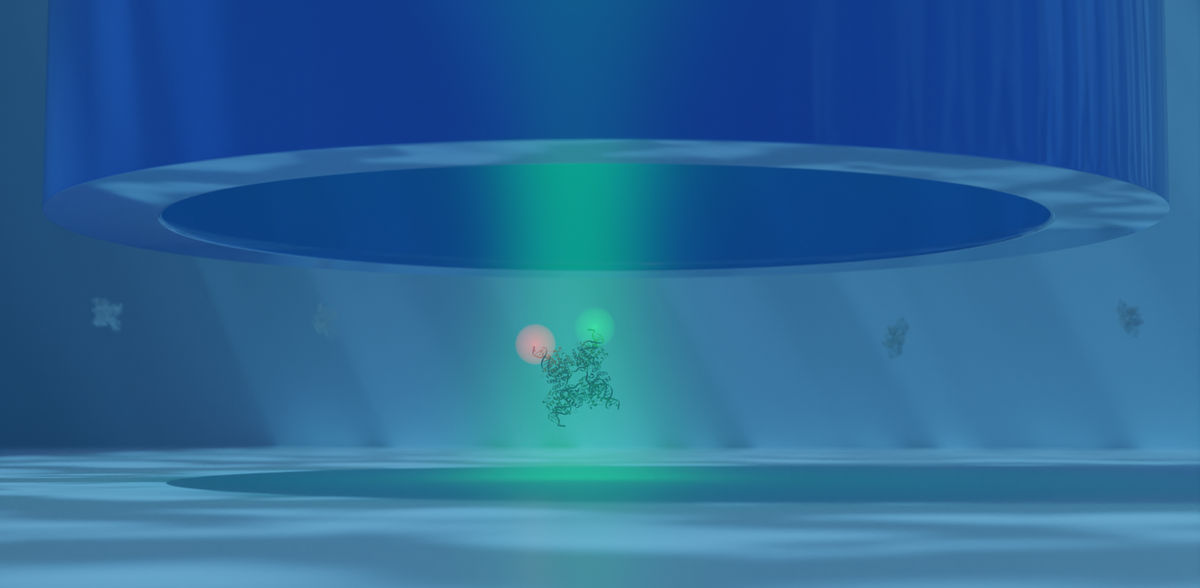Tracking the dynamics of biomolecules with optofluidic antennas
A completely new, highly efficient measurement method
In order to better understand fundamental processes in life science at the molecular level, the precise observation of single molecule dynamics is of utmost interest. However, current techniques based on fluorescence measurements in aqueous solutions are unable to track changes in molecular structure with sufficient temporal resolution. Physicists at the Max Planck Institute for the Science of Light (MPL) have now succeeded in further developing a photonic structure known from quantum optics – the planar optical antenna – for use in aqueous media to monitor dynamic processes. This enables conformational changes of individual biomolecules to be observed with the highest temporal resolution.
To achieve this resolution, the so-called “optofluidic antenna” collects the photons emitted by individual fluorescent molecules with approximately 85% efficiency. With such high efficiency, the researchers are able to achieve a time resolution in the micro-second range. The device can be easily integrated into many existing microscopy setups and is adding another tool providing a high temporal resolution in the laboratory.
Studying the complicated internal dynamics of biomolecules in a liquid environment with single-molecule resolution is of great interest to the life sciences. Fluorescence measurements are currently the cornerstone technique for deciphering fast and slow dynamic processes. Here, special sections of the biomolecules are marked with fluorescent dye molecules. When excited with laser light, changes in their position relative to one another are detected by measuring the emitted photons. However, the collection methodology limits the number of fluorescence photons that can be recorded per time interval thus restricting the temporal resolution.
In the work recently published in the journal Nature Communications, the team led by Professor Stephan Götzinger and Professor Vahid Sandoghdar shows a completely new, highly efficient measurement method that is based on structures known from solid-state quantum optics. Physicists developed the concept of the planar optical antenna approximately 10 years ago and in contrast to conventional optical antennas, a planar antenna can be realized without metallic nanostructures. Through a clever modification, the new optofluidic antennas are able to collect photons emitted by a single biomolecule in solution with extremely high efficiency (85%). The antenna consists of a glass substrate and a layer of water several hundred nanometers thick containing the biomolecules to be examined. The thin layer of water is created by a micropipette positioned just a few hundred nanometers above the substrate. By applying a defined pressure, the shape of the water meniscus in the pipette is controlled. The axial boundary of the water layer forces the molecules to diffuse through the center of the laser focus and thus increases the so-called brightness. The antenna increases the fluorescence signal of the molecules approximately five-fold. At the same time, the water-air interface slows the diffusion of molecules, while the antenna geometry increases the probability that a molecule will return to focus. The MPL scientists demonstrate the performance of the optofluidic antenna together with the group of Professor Claus Seidel, Uni- versity of Düsseldorf, by examining the change in conformity of a specifically arranged DNA – the DNA four-way junction. Two of the legs of the junction are marked with a Förster resonance energy transfer (FRET) pair, where the number of photons emitted by each of the two FRET partners changes with the distance between the two legs. Using FRET trajectories, the researchers were able to prove that a suspected conformational state does not occur and provide an upper limit for its lifespan. The new antenna can track the dynamics of DNA four-way crossing with a temporal resolution of just a few microseconds.
“Our optofluidic antenna works so well due to the improved photon collection efficiency from slower diffusing molecules in the spatially limited channel,” says Professor Stephan Götzinger. “The antenna is a powerful device for investigations in the life sciences. It is not only easy to use, but can also be easily integrated into many existing microscopy setups,” adds Professor Vahid Sandoghdar.
























































